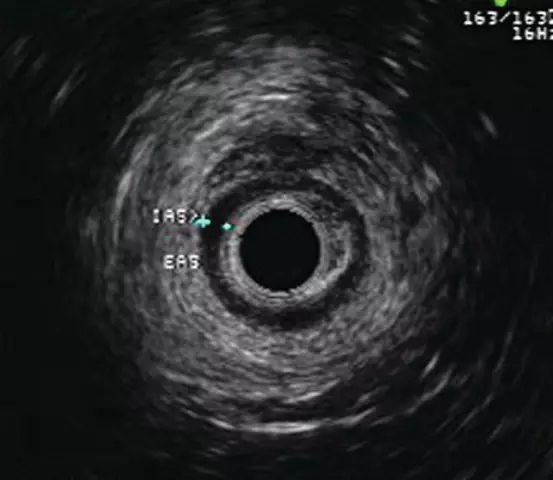- Author Rachel Wainwright [email protected].
- Public 2023-12-15 07:39.
- Last modified 2025-11-02 20:14.
Digestive problems - intestinal spasm

The word "spasm" in translation from Greek means: "constriction, convulsion". From the point of view of physiology, this is a rapid but prolonged contraction of muscle tissue, in which the relaxation phase is delayed. A spasm of striated muscles is called a spasm, and a spasm of a smooth muscle, in particular a tube of the intestine, is called colic.
Intestinal colic or intestinal spasm develops more often in the small intestine, then convulsive muscle contraction is transmitted throughout the digestive tract. Intestinal colic becomes diffuse, the so-called generalized character.
Intestinal spasm, causes
Normally, intestinal contraction occurs in peristaltic waves: ebb and flow. The muscles of different sections work alternately: from the duodenum to the sigmoid colon. The rectum does not participate in the act of peristalsis, and the contraction of the sphincter is not related to the manifestation of intestinal colic. Intestinal spasm develops with extreme irritation of the walls of the intestinal tract, which is caused by the following harmful substances:
- Poisons;
- Parasites;
- Heavy metal salts;
- Bacteria and viruses;
- Decomposition products of the intestinal walls in violation of blood circulation.
With stress reactions, in extremely rare cases, intestinal spasms develop, the symptoms of which appear in the form of a profuse loose stool. Basically, this reaction is typical for animals. Only in people of creative professions suffering from neurasthenia, manifestations of "bear disease" are possible.
Intestinal cramps, symptoms
Irritable bowel syndrome is characterized by the following symptoms:
- The appearance of pain around the navel;
- Feeling of heaviness in the lower abdomen;
- Constipation;
- Diarrhea;
- Flatulence;
- Belching with air, nausea and vomiting.
In severe cases, there is a headache, chills and cold sweats. If intestinal spasm is provoked by acute intestinal obstruction or thrombosis of the mesenteric vessels, the symptomatology increases instantly. The pains spread throughout the abdomen, the anterior abdominal wall tenses. With such a development of the disease, the "calm period" is especially dangerous, during which pain disappears. Loss of sensitivity of the intestinal mucosa indicates the death of receptors due to the onset of necrosis.
Intestinal spasm, treatment
With intestinal colic, it is necessary to relieve the pain, and then undergo an examination to identify the cause of the irritation of the intestines. In case of acute pain, you need to act differently. On the contrary, it is forbidden to take all anesthetic drugs that smooth out the clinical picture. You can independently determine whether an intestinal spasm has occurred or a surgical pathology begins, requiring immediate surgery. If the symptoms are smoothed out, the onset of pain is clearly associated with food intake, one should think that the cause is intestinal spasm, which is treated without surgery.
How to relieve intestinal spasm at home
As a self-help, but not self-medication (!), The following activities are recommended:
- Warm enema, if possible, with a decoction of lemon balm or mint;
- Rectal suppository with belladonna;
- No-shpy tablet.
As a rule, if the spasm of the small intestine is not triggered by an infection or toxins, the pain disappears after a single loose stool or passing gas. If there is no effect, the dosage should not be increased. You need to call an ambulance. Medical specialists know how to relieve intestinal spasm without smoothing out the clinical picture.
In no case should you apply a heating pad to your stomach. This will not solve the problem, but will aggravate the course of the disease.
Despite the fact that intestinal colic is found throughout the abdomen, there are some differences between the small and large intestines.
Small intestine spasm
When the mucous membrane of the small intestine is irritated, the absorption of fluid is disturbed, as a result of which diarrhea develops. Vomiting appears as a defensive reaction of the body.
The developing spasm of the small intestine is characterized by bloating, uterine rumbling, headache, and decreased blood pressure.
As a result of indomitable vomiting and diarrhea, the body loses fluid and important electrolytes, including calcium. Cramps of the striated muscles are added to intestinal colic. The calf muscles are the first to react. General weakness develops rapidly. With viral and bacterial infections, the body temperature rises.
Pain relievers are used to relieve spasm of the small intestine, and saline solutions are given to treat dehydration.
Colon spasm
The involvement of the large intestine in the process is accompanied by an increase in the urge to defecate, which is interspersed with constipation. With irritation of the large intestine, in which the formation of feces occurs, after defecation, patients feel incomplete emptying.

When a spasm of the large intestine becomes chronic, anemia develops in the human body, blood clotting is impaired. This is due to a lack of vitamins that are synthesized in the colon cavity.
Prevention of intestinal spasm
In order to prevent intestinal colic, it is recommended to establish a diet and diversify the diet. Foods necessary for normal peristalsis contain an increased amount of fiber. In addition, eating foods rich in fiber reduces the stress on the digestive system. Also, for the digestion of plant foods, a large amount of enzymes and bile acids are not required.
To exclude the appearance of intestinal spasms, you should eat 4-5 times a day, in such quantity as to leave the table with a slight feeling of hunger. At the same time, there is no need to give up meat dishes at all. A variety of foods stimulate normal peristalsis, which excludes convulsive bowel movements.
YouTube video related to the article:
Found a mistake in the text? Select it and press Ctrl + Enter.






